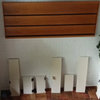I need to remove my linoleum in the kitchen. Is there an easier way?
Kommentare (11)
Cancork Floor Inc.
vor 9 JahrenRemoving flooring can be back breaking but it is a low level skill - for the most part. The question is not "Can I do it myself?" the question becomes "Can I do it properly?" My question becomes, what type of flooring is replacing the lino? This will determine which is the "best" approach to take.
Lino can be removed independantly of the subfloor...the question becomes, "Should it be removed separately or should it be removed WITH the subfloor?" Once the lino is removed, you will need to make sure the subfloor below is perfectly clean (chemicals applied, glue scraped and subfloor sanded).
This approach takes quite a bit of effort, but if you have the time and the energy, it can be done. Many installers/demolition guys will simply remove the substate (can be 1/2" plywood that is attached to the subfloor) and then lay new plywood and start again. They do this because it saves them time...and time is money. Cleaning plywood once a "glue in place" product is removed can take many, many, many hours (several days in some cases).
The choice is yours. You may find that you can do all that work and STILL have to lay new plywood because the scraping/cleaning didn't achieve a level of "clean" required for the next floor. Some people will do half and half. They will lift the lino only to discover the plywood underneath is too far gone (too much glue, water damage, etc) to attempt a "clean up" and they simply save themselves a day or two of work by removing the plywood and laying fresh product. This is quite common.deckerate
Ursprünglicher Verfasservor 9 Jahrendo you have to remove the glue if you are putting down cement board for tile?hayleydaniels
vor 9 JahrenI can't imagine how you're going to get the linoleum up without taking the subfloor it's glued to up at the same time. I just renovated our kitchen and had to take up two layers of flooring, one of which was linoleum, and there was no way of not taking the subfloor up with it.deckerate hat hayleydaniels gedanktCancork Floor Inc.
vor 9 Jahrendeckerate: Yes you need to remove the glue. Any left over adhesive will prevent the bond of the backer board (usually use mortar or mastic together with screws) to the subfloor. You will need to know the type of adhesive/mortar the installer plans on using so you can understand how clean you need to get the plywood underneath.
Please check to make sure your joists can handle the extra load of the tiles. Your flooring installer should have checked your subfloor to ensure you have enough support for the extra weight of tiles. If this is a small square footage (less than 100sf) then you should be OK. On occasion floor joists are too far appart to handle tile...this is easily remedied by installing extra supporting joists from below.
hayley: Demolition professionals have cutting tools that will cut to a certain depth (they preset the depth of the saw). They then cut the upper layer of plywood (with or without the floor attached) into squares (3ft x 3ft or 4ft x 4ft...whatever makes sense in the space). They then use a crow bar to lift the plywood away from the first layer of plywood (that layer is usually what is attached to the joists).
Sometimes it is easier to remove the floor and then remove the screws in the plywood THEN remove the old subfloor...but it all depends on what fasteners have been used.deckerate hat Cancork Floor Inc. gedanktdeckerate
Ursprünglicher Verfasservor 9 JahrenWhat about for a floated engineered wood floor. Maybe I am changing my mind about tile.Rebecca Gingerich
vor 9 JahrenI just did ours and removed the glue with a heat gun and scrapper. Magic! Way fast.deckerate hat Rebecca Gingerich gedanktLorri Baranyai
vor 9 JahrenZuletzt geändert: vor 9 JahrenActually you can go over the vinyl/lino with cement board. The mortar is not being used to bond the cement board - that is done with the cement board screws. The mortar just fills any voids below the cement board. This is a common application when removing the existing vinyl or lino is questionable (i.e. possibly contains asbestos). Going over cushioned vinyl floors is a no-no. You just end up with a soft sandwich in between. The first thing you need to determine is does your subfloor have a deflection issue. Wood floors flex and cement board will not add structural strength to a insufficient subfloor - it will flex with it. If you are planning on laying tiles, you will likely need to beef up the subfloor. You may need to add an additional subfloor on top: 1/2" exterior grade plywood if your current subfloor is 3/4" plywood OR 5/8" exterior grade plywood if your existing plywood is 5/8". Or you could utilize one of the flooring membranes on the market (i.e. Ditra) if you're concerned about height differences. And if you are planning to put down a natural stone floor, the deflection concerns are doubled! Please do some more investigation first - there is nothing worse than laying a new tile floor and having the grout or tiles start cracking months down the road. And there's really no easy way to fix it afterwards - you'll be redoing the whole job. Floating vinyl floors can also be a good solution. There are numerous brand and styles plus they are quieter and warmer than tile. They will also be thinner than tile and mortar.

Marquis Ross
vor 6 JahrenCenCalTile has been in the tile business for over twenty years and we would be privileged to work on your home as stated above we filter 99% of dust and have done up to 1800sq ft in just one day, but that time does vary.We have done work at Clovis Community Hospital,Bank of America's and residential homes all over California...
During the commercial jobs; we keep it so clean businesses are able to continue their everyday business without taking losses.
We do our job with pride,respect and cleanliness.
For more info give us a call at Marquis:559-930-7036
also check out our website http://www.doitdustfree.com/
only contractor in California certified to use the all new Dust Ram/ Dust Free Tech
dmg41058
vor 6 JahrenI too .am removing a linoleum floor send actual)y the flooring is up and we just need to get the glue and paper residue up. What product do you recommend to loosen the glue?
Arizona Home Floors Dust Free Tile Removal
vor 4 JahrenThis is great because we run into this issue here in Arizona all the time. Unfortunately, most homeowners are not able to correctly remove linoleum without either:
A: Making a large amount of dustB: Over-grinding the concrete, making low spots or damaging the concrete
C: Damaging baseboard and cabinets
D: All of the above
What we recommend is that a homeowner contact a certified DustRam Contractor in their area.
These contractors use something called a SurfRam made by DustRam.
Here is a photo of one in use:
In the photo, you can see thinset (glue that holds tile to concrete) being removed, and thinset is at least twice as difficult as linoleum since it's not very even, this SurfRam is attached to a DeWalt 7 inch grinder.
The grinder model being used is a D28499 X, it's a 7-Inch 5.3-Horsepower Large Angle Grinder and it can grind away all of the old linoleum completely dust free, here is a page that shows the SurfRam and linoleum being removed dust free:
Arizona Home Floors Vinyl Linoleum Removal Page
Screenshot from the video:
You can buy that grinder on Amazon for about $150.
The company that manufactures the blue SurfRam attachment for the grinder is located here:
The company that makes the grinder is DeWalt, located here:
Keep in mind that you will want to use a vacuum that pulls in at least 250 CFM (cubic feet per minute) and that is self cleaning.
There are different vacuums out there that work with the SurfRam, but it vacuum MUST have a 2 inch cuff, so don't think any shop vacuum will work because it won't.

Laden Sie die Seite neu, um diese Anzeige nicht mehr zu sehen




Cancork Floor Inc.